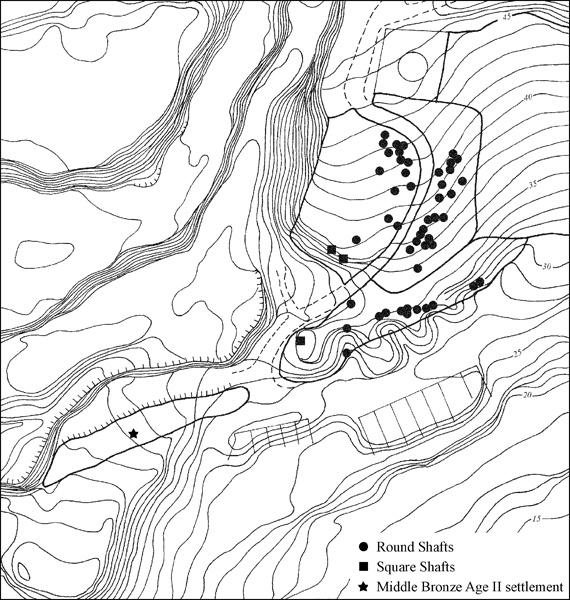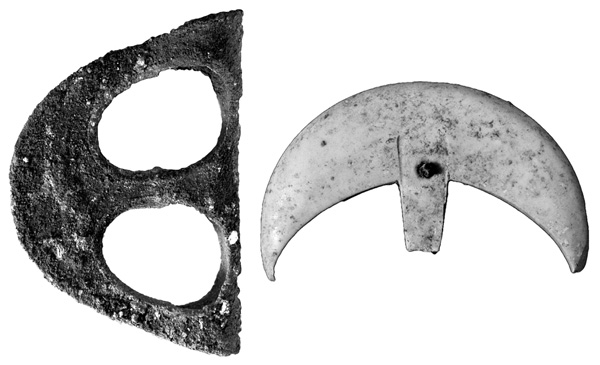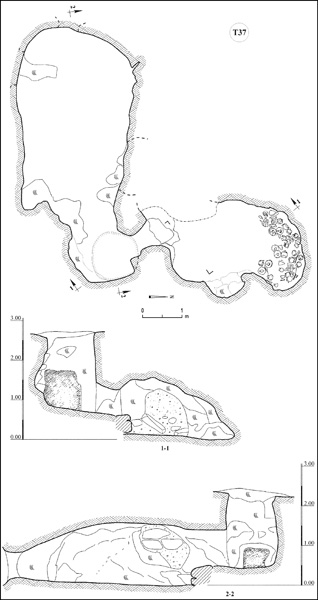Shuni Cemetery (‘Enot Shuni)
INTRODUCTION
In the summer of 2001, ancient tombs were reported to have been revealed and accidentally damaged during quarrying work at ‘Enot Shuni, approximately 3 km northeast of the modern town of Binyamina, at the southern edge of the Carmel Range. A preliminary surface investigation was subsequently conducted by M. Haiman and E. Yannai of the Israel Antiquities Authority. M. Peilstöcker, assisted by H. Cinnamon (GPS mapping), carried out an intensive survey of the area surrounding the southern part of the quarry. As a result of damage from quarrying activities, the original extent of the site remains unclear.
One of the damaged tombs, excavated by D. Sklar in the summer of 2001, is dated to the Intermediate Bronze Age and the Middle Bronze Age II. Additional excavations by A. Gorzalczany in September 2001 revealed that a part of the site on the southwestern slopes of the quarry was covered by the remains of a small settlement dating to the Middle Bronze Age IIA. Further excavations that year, directed by M. Peilstöcker and D. Sklar, investigated more than 90 shaft tombs and additional Roman and Byzantine period remains.
EXCAVATION RESULTS
The excavations and surveys indicate that the site was an Intermediate Bronze Age cemetery reutilized during the Middle Bronze Age II. One excavated tomb was used in the Late Bronze Age, another in the Iron Age. One was a reused Chalcolithic burial cave. In addition to work in these tombs, a mosaic floor found during the survey was shown to belong to a Roman period mausoleum, partly built and partly hewn into bedrock; the mausoleum connects the cemetery with the nearby site of Shuni (see Vol. 4, pp. 1382–1384). The façade of the structure was cleared and preliminary conservation work was conducted in order to prevent its collapse. Near the mausoleum was a lime kiln, possibly Byzantine, which destroyed parts of it.
The site was divided into four areas (1–4) on the southern slope of the hill, with area 4 the highest and area 1 the lowest. The shaft tombs in the cemetery were mostly square, others round, and filled with soil and large stones; some of the tombs were unfinished. All the shafts were hewn into a layer of soft nari limestone; some were partly built of stone. The limestone layer covers a hard dolomite formation, into which one, two, or three burial chambers were cut. The shafts were particularly close to one other in area 4. In most cases, the shafts and entrances to the burial chambers were blocked with large stones. The tomb architecture was simple; in some instances there is a step leading into the burial chamber. Some floors were paved with small stones. Separation walls were found in only a few of the chambers. Most of the tombs were in a good state of preservation, the pottery and other contents largely undisturbed. The roofs of some of the burial chambers, particularly in area 2, had collapsed.

Human and animal bones, including horse bones, were found in the tombs. Most of the human remains were not in articulation. A bone repository containing a large quantity of human bones and a few pottery vessels was found in one of the chambers. When the skeletons were in articulation, the head of the skeleton had been placed close to the wall of the tomb. A group of 23 small vessels dating to the Intermediate Bronze Age and containing infant bones was found in tomb 70.
TOMB 59. Tomb 59 in area 2 is a single-chamber tomb containing two burial layers dated to the Intermediate Bronze Age and the Middle Bronze Age II. The finds from this tomb include a rare fenestrated axe made of silver. The axe appears to be decorated on both sides with an animal motif. Though found in the Middle Bronze Age IIA layer, it may have originated in the Intermediate Bronze Age layer.

TOMB 37. Tomb 37 in area 3 is one of the best-preserved tombs. It has a round shaft, 1.2 m in diameter, cut 1.90 m into bedrock. Its two burial chambers are each connected to the shaft by a narrow entrance and two steps leading down to them, as their floor level is about 0.5 m deeper than the bottom of the shaft. A group of 36 complete pottery vessels was found near the northern wall of the northern chamber, while only 5 vessels were found in the western chamber. Both chambers contained human bones of an undetermined number of individuals. Pottery assemblages are representative of the Intermediate Bronze Age. Most of the vessels are small hand-made spouted “teapots” and amphoriskoi with flat bases.

TOMB 92. Tomb 92 in area 4 is of special interest as it contained a pottery assemblage dating to the early Middle Bronze Age IIA. The tomb consists of a round entrance shaft, c. 3 m deep. From the shaft, a narrow burial chamber less than 1.20 m high is reached through a wide opening. A second opening in the southern wall of this chamber leads to a second chamber, which seems to have originally belonged to a different tomb, since a blocked shaft was found in its northern wall. Seventeen complete pottery vessels were found together with seven metal artifacts, including five spearheads; only two vessels were discovered in the second chamber. The vessels retrieved include bowls, jugs, juglets, and jars, all dating to the early Middle Bronze Age IIA. Since Intermediate Bronze Age pottery was found in the fill, this tomb appears to have been first used in that period, but was apparently cleared before reuse in the Middle Bronze Age II.
MISCELLANEOUS FINDS. There were also a small number of wheel-made “teapots” of the so-called Syrian or Megiddo type. The early Middle Bronze Age II assemblages include decorated vessels of the Levantine painted ware group and at least one fragment of a cut-away neck jug. Among the metal finds are socketed spearheads, some with remains of their wooden handles. Also uncovered were stone pommels, beads, worked bones, and bone inlays.
SUMMARY AND CONCLUSIONS
The tombs were quarried in the Intermediate Bronze Age (2200–2000 BCE). Most were reused during the Middle Bronze Age IIA and/or the Middle Bronze Age IIB. Exceptions are one Chalcolithic tomb and burials dating to the Late Bronze Age and the Iron Age II. When a previously existing tomb was accidentally encountered, the new tomb was not used and the opening was blocked.
The Intermediate Bronze Age tombs contained multiple primary burials, some serving members of a single family, as indicated by the anthropological report. The ceramic repertoire of the period is highly standardized and quite limited, consisting mainly of small vessels such as “teapots,” amphoriskoi, small jars, and jugs. The vessels are similar to ones found in other burials dating to the period, though cooking pots are absent at the site. They resemble those of the northern culture, although so-called Syrian vessels are rare. Metal artifacts include tools and weapons, such as axes.
The Middle Bronze Age II burials were relatively poor in comparison to ones known at other sites. Assemblages of the period display a wide range, including all vessel types. Noteworthy vessels of the early phases of the period are examples of the so-called Levantine painted ware and other related wares. Other Middle Bronze Age II artifacts include metal objects such as toggle pins and rings, scarabs, bone inlays, and beads.
In conclusion, the site is significant in view of the large number of tombs that were excavated. Although the cemetery of ‘Enot Shuni is not unique, it helps in gaining a better understanding of the Intermediate Bronze Age and the Middle Bronze Age II, particularly given how little is known of the former period in the region. Moreover, the close chronological proximity of the Intermediate Bronze Age and the Middle Bronze Age IIA burials may shed new light on the beginning of the Middle Bronze Age II. The proximity of the Intermediate Bronze Age tumuli of Ramat ha-Nadiv to the burials at Shuni is significant in attempting to better ascertain the nature of the population and chronology of the Intermediate Bronze Age. The large number of tombs and their good state of preservation provide us with an excellent database for further research.
MARTIN PEILSTÖCKER
INTRODUCTION
In the summer of 2001, ancient tombs were reported to have been revealed and accidentally damaged during quarrying work at ‘Enot Shuni, approximately 3 km northeast of the modern town of Binyamina, at the southern edge of the Carmel Range. A preliminary surface investigation was subsequently conducted by M. Haiman and E. Yannai of the Israel Antiquities Authority. M. Peilstöcker, assisted by H. Cinnamon (GPS mapping), carried out an intensive survey of the area surrounding the southern part of the quarry. As a result of damage from quarrying activities, the original extent of the site remains unclear.
One of the damaged tombs, excavated by D. Sklar in the summer of 2001, is dated to the Intermediate Bronze Age and the Middle Bronze Age II. Additional excavations by A. Gorzalczany in September 2001 revealed that a part of the site on the southwestern slopes of the quarry was covered by the remains of a small settlement dating to the Middle Bronze Age IIA. Further excavations that year, directed by M. Peilstöcker and D. Sklar, investigated more than 90 shaft tombs and additional Roman and Byzantine period remains.
